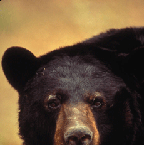 The New York Cooperative Fish and Wildlife Research Unit is planning two black bear studies.One will study New York’s black bear population as it moves into new areas. GPS-collared bears will be tracked in core habitats and fringe areas. The researcher will compare how bears chose habitats and when they use habitats in the core areas to where to when they are active in newly populated areas. Another study will use DNA to estimate the population of black bears in those newly-occupied regions of the state. The study will use mitochondrial DNA markers from hair samples snagged on barbed-wire snares for a mark-and-recapture survey of sorts. More details are available in the NY Cooperative Unit’s newsletter.
The New York Cooperative Fish and Wildlife Research Unit is planning two black bear studies.One will study New York’s black bear population as it moves into new areas. GPS-collared bears will be tracked in core habitats and fringe areas. The researcher will compare how bears chose habitats and when they use habitats in the core areas to where to when they are active in newly populated areas. Another study will use DNA to estimate the population of black bears in those newly-occupied regions of the state. The study will use mitochondrial DNA markers from hair samples snagged on barbed-wire snares for a mark-and-recapture survey of sorts. More details are available in the NY Cooperative Unit’s newsletter.
 In Oklahoma, biologists with the Oklahoma Department of Wildlife Conservation are planning a big study of bobwhite quail to gather the data needed to try to rebuild bobwhite quail populations in the Rolling Plains in the western part of the state. The study will investigate toxins, weather, parasites, and predators as potential causes of the bobwhite quail population’s decline. The biologists will coordinate their efforts with biologists in west Texas, since the Rolling Plains region crosses state lines. Read more in the Oklahoman. More info on quail in the Rolling Plains is available from the Rolling Plains Quail Research Ranch (which is in Texas).
In Oklahoma, biologists with the Oklahoma Department of Wildlife Conservation are planning a big study of bobwhite quail to gather the data needed to try to rebuild bobwhite quail populations in the Rolling Plains in the western part of the state. The study will investigate toxins, weather, parasites, and predators as potential causes of the bobwhite quail population’s decline. The biologists will coordinate their efforts with biologists in west Texas, since the Rolling Plains region crosses state lines. Read more in the Oklahoman. More info on quail in the Rolling Plains is available from the Rolling Plains Quail Research Ranch (which is in Texas).
Photos: Bobwhite: Dan Sudia, US Fish &Wildlife; Black bear, US Fish & Wildlife
